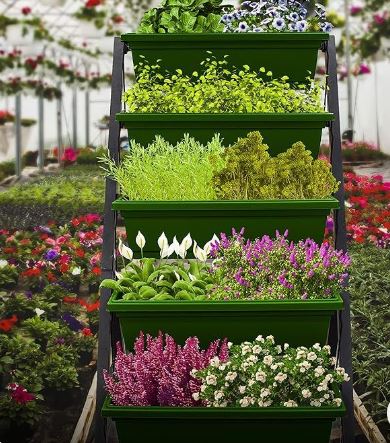Choosing the right flowers for your planter boxes can make your garden look amazing. Colors, bloom times, and care are important factors to consider.
You need to know how much sunlight they need, how often to water them, and how to keep pests away. By understanding these things, you can make sure your garden stays beautiful all year.
So, pick the right flowers for your planter boxes and watch your outdoor space come to life!
Key Takeaways
- Choose flowers like petunias, marigolds, and geraniums that have colors that look good together.
- Pick some plants that bloom all year and some that bloom only during certain seasons for a variety of flowers.
- Put the planter boxes in spots where they get sunlight for at least 6–8 hours every day.
- Make sure there are holes in the bottom of the planter boxes so water can drain out and the roots don’t rot.
- Trim and remove dead flowers to keep the plants healthy and blooming.
Selecting the Right Flowers
When picking flowers for your planter boxes, consider the amount of sunlight they’ll get. Some flowers, like petunias and marigolds, need lots of sun, while impatiens and begonias like some shade. Knowing this will help your flowers thrive all season.
To keep your planter boxes colorful, choose flowers that bloom at different times. Mix early bloomers like pansies with mid-season favorites like geraniums for a changing display. Using both annuals and perennials will give you a mix of long-lasting blooms and seasonal variety.
For visually stunning planter boxes, pick flowers with colors that go well together. Combining purple and yellow or pink and white can make your garden stand out. Choose low-maintenance flowers that suit your area’s climate and soil for easy care of your planter boxes.
Choosing the Best Planter Material
When choosing materials for planter boxes, consider:
- Wood for a classic look
- Metal for durability
- Concrete for sturdiness
- Ceramic for elegance
- Plastic for affordability and easy maintenance
Think about your garden’s style and maintenance preferences to pick the best material for your raised beds.
Determining the Ideal Size
To have the best plant growth and flexibility in arranging them, follow these recommended dimensions for your planter box. The ideal size is usually around 32 to 36 inches long, 14 to 18 inches wide, and 6 to 12 inches deep.
A larger planter box, like one that’s 36 inches long, 18 inches wide, and 12 inches deep, can hold more plants and allow for elaborate designs. A smaller box at 32 inches long, 14 inches wide, and 6 inches deep is great for tighter spaces or simpler plant setups.
Consider these sizes carefully to make sure your plants thrive and your garden looks great in the planter box.
Positioning for Optimal Sunlight
To make sure your plants grow well, place your planter boxes where they’ll get 6–8 hours of sunlight each day. Watch out for buildings or trees that might block the sun. Rotate your planter boxes during the day so all sides of your plants get sunlight. Be careful of too much heat or direct afternoon sun, as it can harm your plants.
Use stands or platforms to lift your window boxes for better sunlight and airflow, which helps your plants stay healthy. With the right sunlight, your garden will bloom beautifully.
Watering and Drainage Tips
To keep your planter boxes healthy, make sure they have holes for drainage. This stops water from building up and causing root rot.
When watering, give your plants a good soak and let excess water drain out. Follow a watering schedule based on your plant’s needs and the weather to keep the soil at the right moisture level.
Consider using self-watering planter boxes or water reservoirs to help you water your plants consistently. Check the top inch of soil regularly to see if it’s dry before watering again. This way, you can avoid both underwatering and overwatering, and your plants will thrive.
Proper drainage and watering are key to keeping your garden flowers vibrant and happy.
Fertilizing Your Flowers
To help your garden flowers grow well, you need to give them fertilizer. This fertilizer has important nutrients like nitrogen, phosphorus, and potassium.
For planter boxes, it’s best to use a balanced fertilizer with equal amounts of these nutrients, like a 10-10-10 mix. You should apply the fertilizer before the flowers start growing in the spring.
Be careful not to use too much fertilizer, as this can make the plants grow too many leaves instead of flowers. After fertilizing, make sure to water the plants well so the nutrients can reach the roots.
Following these steps will give your planter box flowers the food they need to bloom beautifully and grow strong in your garden.
Pruning and Deadheading Techniques
When cutting back and removing old flowers in your garden, use sharp, clean tools to make precise cuts. This helps your plants stay healthy and keeps them blooming all season.
Taking care of your plants in planter boxes is super important to keep your garden looking beautiful. Here are some tips to help you become a pro at cutting back and removing old flowers:
- Keep Up with Maintenance: Make sure to cut back and remove old flowers regularly to keep your plants in planter boxes looking their best all season.
- Trim Carefully: Focus on cutting off any dead or sick branches when you prune to stop diseases from spreading and help new growth thrive.
- Timing is everything. Remove faded flowers quickly to help your plant put its energy into making new blooms. This way, your planter boxes will have flowers for a longer time.
Dealing With Pests and Diseases
Check your plants often for bugs or diseases. Use natural methods like beneficial insects or neem oil in your planters to keep pests at bay.
Look out for common signs like wilting, color changes, or strange spots on your plants. Rotate the types of crops you grow in your planters to prevent pests and diseases from sticking around.
Choose plants that are resistant to diseases when possible to lower the chances of infections. Remove any dead or sick plant parts quickly to stop diseases from spreading.
Seasonal Care Guidelines
To keep your plants healthy in planter boxes, watch out for signs of water stress. Make sure your planter box beds are big enough for the roots to grow well. Check for drainage holes to avoid waterlogging, which can harm the roots.
Use a balanced fertilizer to give your plants the nutrients they need for strong growth. Remember, too much fertilizer can be bad for your plants, so follow the instructions carefully.
With these tips, your planter boxes will thrive all year round!
Enhancing With Accessories
Enhance your planter boxes with trellises, plant stands, and decorative rocks for a better look. These additions add height, texture, and interest to your planters.
Consider adding hanging hooks for more hanging space or decorative items. Solar-powered lights or lanterns can light up your garden at night for a cozy feel.
Weather-resistant cushions can provide comfort near the planter boxes for a relaxing outdoor spacehttps://diychimney.com/garden-swing-relax-enjoy-your-outdoor-space/
. Watering systems or self-watering devices help ensure your plants get the right amount of moisture for their health.
Incorporating these accessories can make your planter boxes stunning and functional.
Maintenance and Longevity Tips
To keep your plants in planter boxes healthy, make sure to water them regularly. This helps them stay vibrant and grow well. Here are some key tips for caring for your plants in planter boxes:
- Good Drainage: Having proper drainage in your planter boxes is essential to prevent water from pooling and causing root rot. This way, your plants get the right amount of water they need to thrive.
- Fertilize Regularly: Giving your plants fertilizer regularly provides them with important nutrients for strong growth and beautiful flowers. It keeps them healthy and strong.
- Pest Control: Keeping pests away is important to protect your plants from harm. By managing pests effectively, you can ensure your plants in planter boxes live long and look stunning in your garden.
Frequently Asked Questions
How Do You Arrange Flowers in a Planter Box?
Start with pansies and violas for the bottom layer of your planter box. Add white Nancy lamium for a frilly front look. Mix in other colorful flowers and green plants for a balanced arrangement. Remember to group plants in odd numbers for a more artistic touch.
How Do You Start a Garden in a Planter Box?
To start a garden in a planter box, you need a sunny spot, nutrient-rich soil, plants that fit, and regular watering and fertilizing. Make sure to drill drainage holes in the box before filling it with soil. Container gardening is perfect for small spaces.
How Deep Should a Planter Box Be for Flowers?
For flowers in a planter box, the soil needs to be at least 6 inches deep for optimal growth. It’s better to aim for roots that are 8–12 inches deep to have healthy roots. Deeper boxes hold water well and support taller plants. So, choose wisely for beautiful and vibrant blooms!
What flowers grow well together in pots?
Pair marigolds with petunias, geraniums with lobelia, zinnias with salvia, nasturtiums with sweet alyssum, and snapdragons with verbena for a successful companion planting in pots.
Conclusion
To make your garden look beautiful, choose the right flowers, planter, and sunny spot for your planter box.
Water, trim, and check for bugs regularly to keep your plants healthy.
With good care, your garden will be lovely all season.
Enjoy your garden with pretty flowers in your planter boxes!











